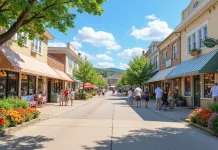Exploring the Hidden Gems of Architectural Beauty
The United States is a canvas of architectural wonders, where towering skyscrapers often capture the limelight. However, beyond the bustling metropolises lie underrated cities with their own architectural marvels. These places are waiting to tell their unique stories through structures of historical significance, avant-garde designs, and inspired creativity.
Santa Fe, New Mexico: Adobe and Artists Unite
The Essence of Adobe Architecture
Santa Fe stands as a testament to the enduring appeal of adobe architecture. The city is dotted with structures made from mud bricks, giving the area a unique earthy aesthetic. The adobe style is rooted in Pueblo Native American techniques and Spanish colonial influences, creating a harmonious blend of cultures. A stroll through Santa Fe offers a view of homes and buildings painted in warm hues that complement the sweeping desert landscape.
The Influence of Native American Culture
The architecture here is not just about the materials but also the cultural narratives they embody. At the Museum of Indian Arts & Culture, you can witness how Native American traditions manifest in both traditional and contemporary art. This is an excellent stop for anyone interested in understanding how architecture serves as a vessel for cultural expression.
Artists’ Mecca
Santa Fe’s architectural allure is enriched by its extensive art scene. Walk through Canyon Road, where adobe facades host numerous galleries showcasing everything from classic to contemporary art. The connection between the built environment and artistic expression makes Santa Fe a truly holistic architectural wonder.
Charleston, South Carolina: A Dip Into the Southern Charm
Exploring Antebellum Architecture
Charleston offers a rich tapestry of Antebellum architecture that gives insight into its storied past. The pastel-colored streets are lined with well-preserved mansions and churches that date back to the 18th and 19th centuries. These structures feature intricate ironwork, sprawling piazzas, and grand columns, all of which are hallmarks of the Southern architectural style.
Preservation and Its Challenges
The city has been committed to preserving its architectural treasures, which is a constant balancing act. Efforts include maintaining the historic integrity while accommodating modern-day needs. Visiting the Nathaniel Russell House or the Aiken-Rhett House offers a glimpse into early 19th-century domestic life and the architectural craftsmanship of that era.
A Modern Take
Recent years have seen new developments that respect Charleston’s historical roots while integrating contemporary architecture. The Gaillard Center is an example of modern design serving the community while paying homage to classical styles. The juxtaposition of the old with the new makes Charleston an interesting study in architectural evolution.
Minneapolis, Minnesota: The Intersection of Modern and Gothic Revival
Modern Marvels
Minneapolis is a city that thrives on innovation, a characteristic that extends to its architecture. The Walker Art Center and its adjacent Minneapolis Sculpture Garden offer an avant-garde perspective that contrasts with the city's historical structures. The center is famous for its modernist design, reflecting the city’s dedication to contemporary art.
Gothic Revival in an Unlikely Place
While it may seem unexpected, Minneapolis is home to impressive Gothic Revival architecture. The Basilica of Saint Mary is a striking example, boasting intricate stonework and soaring arches. It’s a place where spiritual significance meets architectural brilliance, making it a must-see for visitors interested in the interplay between design and function.
Bridges of Significance
Minneapolis is also well-known for its impressive collection of bridges, which connect the city across the Mississippi River. The Stone Arch Bridge, in particular, is not only a historical landmark but also a beloved example of engineering prowess. It serves as a scenic path for pedestrians and cyclists, offering stunning views of the city skyline.
Savannah, Georgia: A Living Museum of Period Architecture
The Quintessential Georgian Style
Savannah is celebrated for its well-preserved architecture that spans from colonial times to the Victorian era. The city's squares are peppered with homes displaying the symmetrical lines and decorative elements of the Georgian style. The Davenport House Museum captures this essence with period-accurate decor and structure.
Victorian Beauty
As you move further into the city, the Victorian District reveals another layer of architectural beauty. The area showcases a colorful array of Queen Anne homes featuring turrets, verandas, and intricate woodwork. These residences serve as an architectural narrative of Savannah’s prosperous late 19th-century history.
Innovative Public Spaces
Savannah also stands out for its comprehensive urban planning. The city is organized around 22 park-like squares that offer green spaces in the midst of urban life. These public areas bind the community and create a unique blend of built and natural environments.
Pittsburgh, Pennsylvania: Steel City's Surprising Architectural Diversity
Industrial Roots and Transformation
Known as the Steel City, Pittsburgh's architecture reflects its industrial past and artistic present. The adaptive reuse of factories has led to innovative spaces like the Heinz History Center and the Carrie Furnaces, showcasing how old structures can serve new purposes.
A Medley of Styles
Pittsburgh’s neighborhoods offer an eclectic mix of architectural styles. In the Mexican War Streets, you'll find restored Victorian homes. Schenley Farms exhibits early 20th-century elegance with its Beaux-Arts buildings. Each area has its own story, making Pittsburgh a living archive of architectural evolution.
Skyline Innovation
The skyline tells another side of the story, with modern skyscrapers like the U.S. Steel Tower and PPG Place. These buildings not only provide for business but also offer a futuristic aesthetic that complements Pittsburgh's classic architecture, creating a cityscape that is as varied as it is cohesive.
Burlington, Vermont: The Harmony of Nature and Architecture
Historic Residences
In Burlington, architecture is as much about preserving history as it is about embracing nature. The University Green Historic District captures the city's tradition through colonial and federal-style homes that harken back to Burlington’s early days. Walking through Burlington feels like stepping into a well-preserved moment in time.
Eco-friendly Innovations
Modern architecture in Burlington leans toward sustainability. Structures incorporate eco-friendly designs that harmonize with the natural environment, such as green roofs and LEED-certified buildings. The city's commitment to sustainability has fostered an architecture that not only looks good but also feels responsible.
The Waterfront Revitalization
A key part of Burlington’s appeal is its waterfront. The area has been revitalized with public spaces and mixed-use developments that offer scenic views of Lake Champlain. The preservation of natural beauty alongside architectural innovation makes the waterfront a beloved community space.
Discovering the Unique Narratives of Architectural Underdogs
Each of these cities tells its own story, a narrative composed of wood, brick, stone, and steel. Visiting them is like opening a book where every chapter reveals another facet of American architectural diversity. Though they may lack the immediate recognition of their bigger counterparts, these cities offer something more profound—the opportunity to see history and innovation side by side, to witness how different stylistic choices reflect cultural evolutions and technological advancements. As you journey through these lesser-known cities, you’re not only exploring architectural wonders but also discovering what makes each city uniquely remarkable in its own right.






























